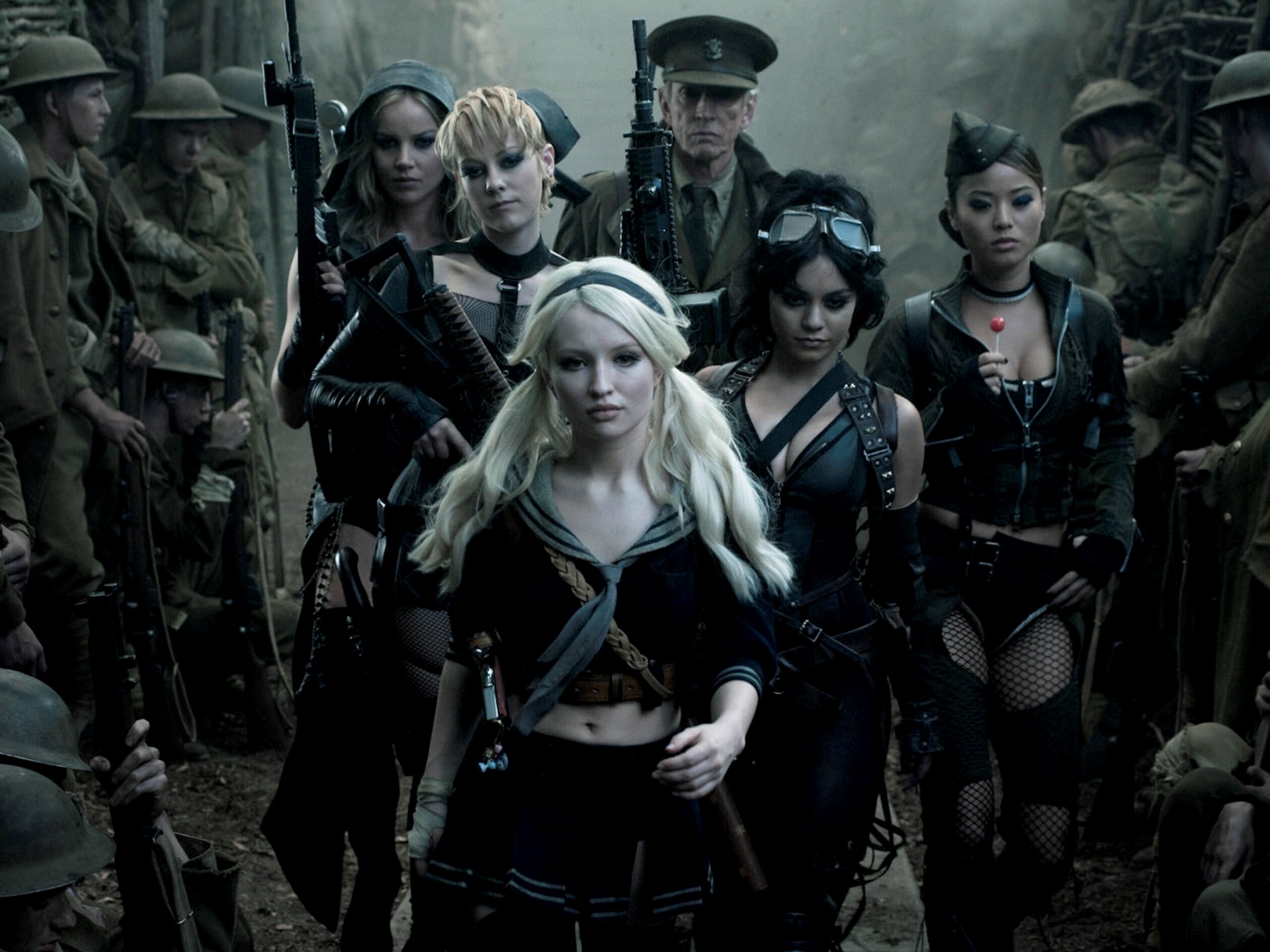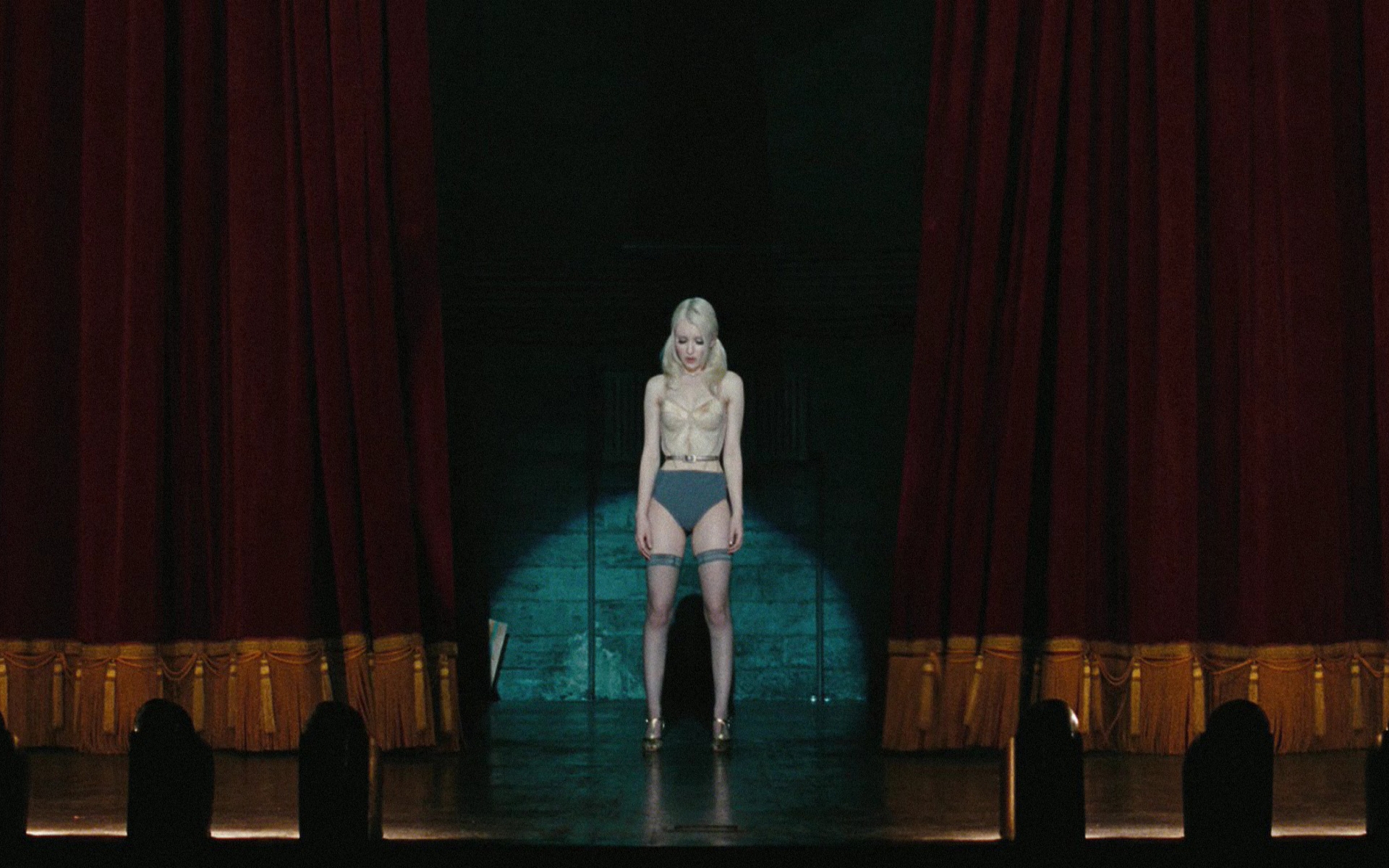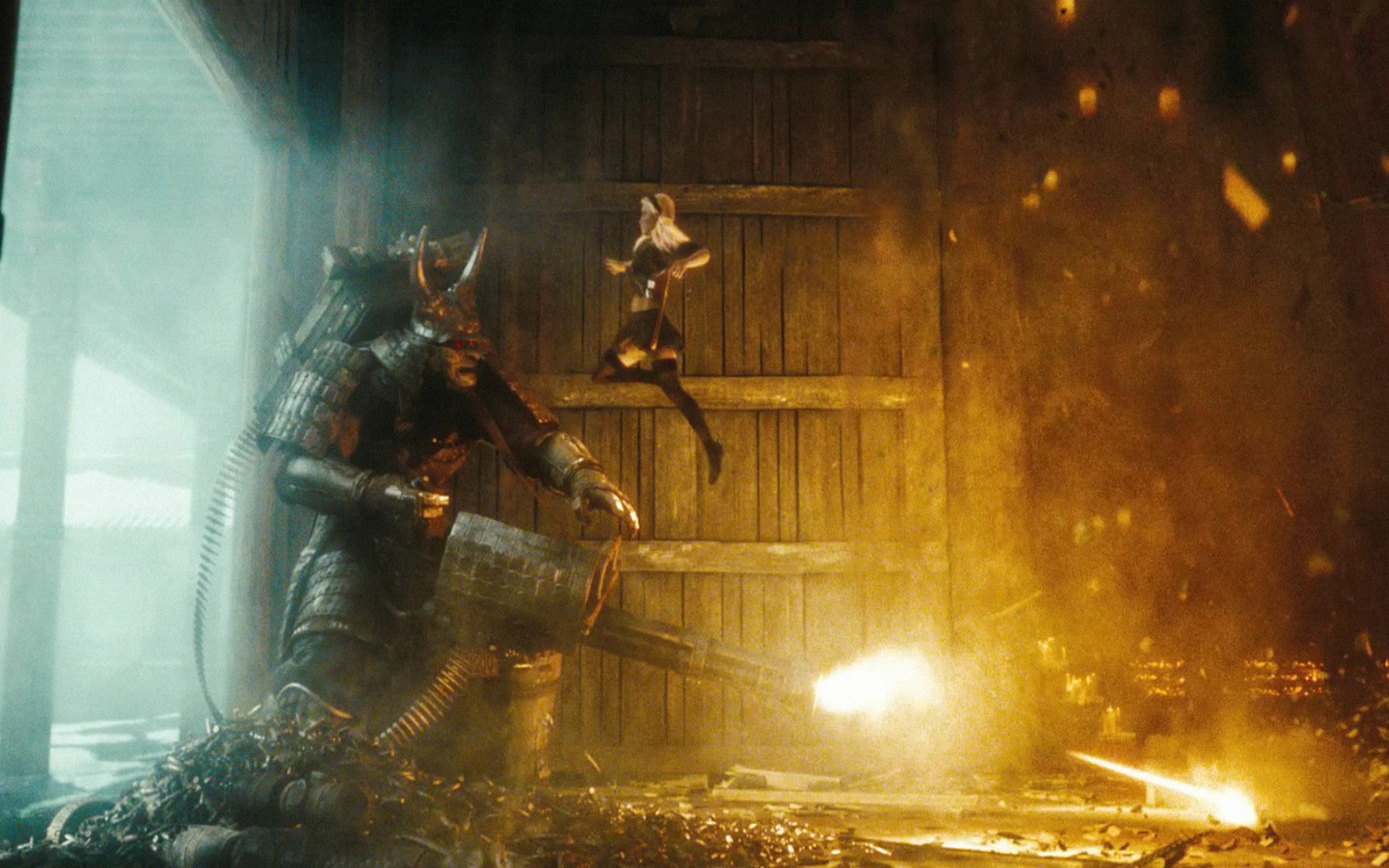Warning: This review may contain traces of spoilers, and may have come into contact with spoilers from other movies.
http://www.youtube.com/watch?v=MnF4SpS9gUw
Only two weeks after its release, Zack Snyder’s film Sucker Punch plummetted from the box office top ten, sealing its fate as a flop. Snyder’s first film not based on pre-existing source material (though clearly influenced by several pre-existing properties), Sucker Punch seemed like it should be a surefire hit. With young, nubile, scantily-clad women in short skirts weilding swords and machineguns to kill dragons and zombie Nazis, the movie is jam-packed with the stuff nerdy male dreams are made of. It’s essentially the margins of every school notebook I owned between ages 14 and 17 brought to life…so how did it go so wrong? Is Sucker Punch suffering the same fate as Scott Pilgrim vs. The World – another film which failed to find an audience on the big screen and was deemed a huge box office bomb? While Scott Pilgrim is definitely the better film of the two, they both have many similarities, and much like with Scott Pilgrim, I think audiences are dismissing Sucker Punch as all style and no substance when really, if you look just below the surface, you’ll find that there are interesting ideas at work. That isn’t to say Sucker Punch doesn’t have its flaws, but I strongly believe that there’s more to Sucker Punch than people are giving it credit for.
Sucker Punch tells the story of Babydoll, a platinum blonde babe played by Emily Browning (A Series of Unfortunate Events), whose mother dies leaving her and her sister in the custody of her evil step-father. Learning that Babydoll’s mother left everything to Babydoll and her sister in her will, the evil step-father decides to kill both his step-daughters so that the inheritance will pass to him. He succeeds in killing Babydoll’s sister, but when she pulls a gun on him, he instead has her committed at one of the most sinister-looking asylums you can imagine. After settling in, under the guidance of Madame Gorski (Carla Gugino), Babydoll begins to slip out of reality and into an alternate world which exists only in her imagination (maybe). In this alternate reality, Babydoll and the other girls in the asylum (played by Abbie Cornish, Jena Malone, Vanessa Hudgens and Jamie Chung) are prostitues and burlesque dancers at a brothel lorded over by Gorski and the head orderly Blue (Oscar Isaac). After learning that the High Roller (in reality a lobotomy specialist played by Jon Hamm) is coming to take Babydoll’s virginity in a few days’ time, Babydoll hatches a plan to escape and enlists the other girls in her scheme. In order to pull off their plan, however, they need to find five things…and this is where the movie really gets wild. To obtain the items they need to complete their quest for freedom, the girls drop deeper out of reality and into another alternate world, this one loaded with zombie Nazis, zeppelins, dragons, robots, bullet trains, mechs, and all that other great stuff. Guided by a mysterious wise man (Scott Glenn), it’s a race against time to escape the asylum before the High Roller arrives and all is lost.

Sucker Punch is Zack Snyder’s Kill Bill. Much like Kill Bill, Sucker Punch is a mash-up of elements of popular culture, drawing from stories like Alice in Wonderland, movies like Inception and Shutter Island, martial arts flicks, anime, comic books, and video games. It’s as though Zack Snyder thought that by combining the best bits of all these different aspects of pop culture, he’d wind up with the perfect property, which is, unfortunately, not the case. The similarities to Kill Bill don’t end there, however, as many of Sucker Punch‘s story elements are very similar to Tarantino’s masterpiece. For one thing, the protagonist is a sexy blonde with a samurai sword. For another, she has a list of five things she needs to do in order to achieve her goal. Scott Glenn’s sensei is a lot like Pai Mai, and even the idea of the mysterious High Roller drawing ever closer to our heroine brings David Carradine’s Bill to mind. But again, Sucker Punch doesn’t even come close to touching the awesomeness of Kill Bill, and I’ll tell you why. Whereas Kill Bill was rooted in the grindhouse style of film, aping and paying homage to classic chop-socky flicks and spaghetti westerns, Sucker Punch isn’t really rooted in anything. It’s not trying to appeal to fans of a particular genre of film, it’s trying to appeal to a much wider audience, and in mixing intellectual and philosophical elements (questions like “what is reality?” and subjects like the coping mechanisms of victims of abuse) with flashy, mindless, short-skirted action sequences, it fails to find a middle ground. People interested in mind-bending movies like Inception or Shutter Island will be put off by all the machineguns and explosions, and people who want sexy chicks fighting zombies will be put off by the heavier subtext. Clearly, Snyder thought he could have his cake and eat it too.

In spite of the film’s flaws, however, I found it to be quite refreshing in its construction. While the story isn’t anything to write home about, the fact that Snyder allows certain parts of it to live in ambiguity, giving the audience the chance to form their own opinions and theories about what’s really going on, is a breath of fresh air, since most movies feel the need to spell everything out for the viewer. Even Inception, which I absolutely love, spends at least a half hour of its total running time just explaining everything that’s going on to the audience. Sucker Punch just drops you into the deep end, challenging you to figure out the meaning behind all the zombies and mechanized gunmen, and I appreciated not being beaten over the head with exposition.
So what’s really going on in Sucker Punch? I’ve been dancing around the answer to this question for the bulk of this review, so I might as well get into it now. As I mentioned before, the film can be read as an exploration of the coping mechanisms of victims of abuse. One of the ideas at the core of the movie is that a person can gain control over their fears and hardships by retreating into their head, by living in a fantasy world instead of the real world. Since Sucker Punch deals in not one, but two different levels of fantasy, it’s not a stretch to see how this reading can be applied to the movie. A lot of people have decried Sucker Punch as being sexist, or at least anti-feminist, but I don’t see it as such. The fact that the imaginary version of the asylum is a brothel, the fact that Babydoll has to perform sexy dances to transport herself and her allies into the world of mechs and samurai demons with gatling guns, and the fact that the girls all wear skimpy clothing while kicking ass all suggest that the girls are using their sexuality to gain control over their situation. Their sexuality becomes their weapon, and they use it to reclaim their freedom.

The character of Babydoll is another interesting aspect of Sucker Punch. There’s a particular moment that occurs near the end of the first act of the film that suggests some rather unusual things about the platinum blonde sword-swinger: shortly after arriving at the asylum and overhearing that she’s to be lobotomized, we see a montage of Babydoll growing accustomed to life in the institution. The montage concludes with Babydoll about to recieve her lobotomy…but right as the hammer is about to hit home, the film cuts to Sweetpea (Abbie Cornish) in a Babydoll costume, acting out the lobotomy scene on a stage in the asylum’s main recreation room. As the film progresses, we discover that Sweetpea’s story involving the death of her sister Rocket (Jena Malone) is oddly reminiscent of Babydoll’s backstory…and by the end of the film, we discover that Sweetpea may have been the main character all along. It’s a complicated idea to describe in writing, but the jist of it is that Babydoll and Sweetpea are connected somehow. Babydoll’s montage even begins with her making eye contact with Sweetpea. So what does this mean? There are a few different interpretations. One is that Babydoll doesn’t exist – that she is a fabrication of Sweetpea’s imagination. Perhaps Sweetpea was lobotomized, and the whole movie is a fantasy in her injured mind, with Babydoll being Sweetpea’s projection of herself. Another reading could be that the entire movie took place in Babydoll’s imagination in that instant before she was lobotomized. The movie opens with a curtain rising (similar to the open of Moulin Rouge) onto the scene of Babydoll’s mother dying – could this point to another reading: that the whole film is trying to say that it is the audience’s imaginary, escapist world? Again, I find myself having difficulty explaining these ideas in terms that would be understood by someone who hasn’t seen the film. Regardless, I think the fact that the film can be interpreted in so many different ways shows that it’s not just the mindless boobs-and-guns film that people have been dismissing it as. Though it does have a fair share of mindlessness too.

Before I wrap this up, and I do hope this review has made some kind of sense, I feel that I should talk about the action sequences that the movie seems to be built around. These are the bits of the film that were shown in just about all of the previews – the parts that put the wrong people off the movie and drew the wrong people to it. Each time Babydoll dances, the girls are transported to the weird fantasy world with ringed planets in the sky, WW2 war machines in the air and zombies and orcs on the ground. The formula for these scenes is always the same: the girls fight their way to a big boss and kill it to obtain whatever item they’re after. The sequences are fun to look at, but they really are all flash and no bang, pure style over substance, and I will admit that I found it hard to get invested in them. They’re basically over-the-top music videos (Zack Snyder’s commentary on how we consume media through video games, comics, music videos and movies, perhaps?), and while they are fun in their own way, they don’t really jive with the rest of the film. They’re not bad, and I didn’t feel like they dragged the movie down at all, but they’re not as cool as they think they are. Again, I feel as though these bits, which Snyder clearly wanted to be the heart of the movie, are probably the biggest obstacle in the way of getting the right people to watch it.
Sucker Punch is a fine film. It’s much better than many movies I’ve seen recently, and it’s actually pretty smart in its construction. Snyder may go overboard with the visual flare from time to time, but there’s a story here, and it’s not a stupid one. Much like with Scott Pilgrim, I feel like Sucker Punch is being unfairly judged or taken at face value, when really, if you just look beyond the explosions, you’ll see that there is substance. It’s just hidden behind lots and lots and LOTS of style.
3.25 out of 5
